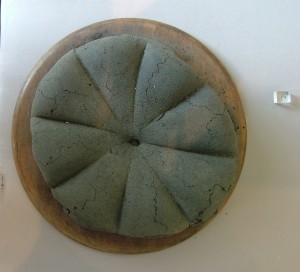It’s all about the fear… when you never get to eat your daily bread.
I made it to Day 1 of the much-awaited British Museum exhibition on these two Roman cities – not because of careful planning but because, when I went online to book, that was simply the first day when slots were available. Getting in early meant getting a sense of it for myself, before the rest of the media and blogosphere came in with their reactions. So, how was it for me? Surprisingly good, and a fresh approach; before I went, I thought I knew about Pompeii (not least from the graffiti – e.g. ‘Chie, I hope your haemorrhoids rub together so much that they hurt worse than when they ever have before!’) – but I found much new here.
The space is laid out as the rooms of a large Roman home, with each object in the appropriate room. The organisers make the point that some activities didn’t have a room of their own: children were carried around the home with their parents (no ‘nursery’ or ‘playroom’), while sex happened pretty well anywhere, with a preference for the cubiculum, a dark room off a main room. The furniture from Herculaneum is astonishingly well preserved; tables, parts of a bed, a baby’s cradle. It is hard not to tell yourself stories about the people who would have used these objects. The ‘home’ includes the garden – superb frescoes of foliage and birds! – and here I felt that the air-con was a little lower, giving a sensation of the coolness that would have been expected in this precious bit of the countryside brought into the town. And the exhibition works with other senses too; there are faint sounds, birds in the garden, busy-ness from the street outside… It’s very clever, but doesn’t get in the way.
As for the objects, nobody wanted to get too close to the craftsmanship of the notorious statue of Pan getting frisky with a goat. Funny, that. I loved this – it really made me laugh, and made me wonder if that’s how its original viewers would have reacted. Pan is, after all, a goat beneath the waist, so why not fall for a – er – total goat? The dormice jar – for fattening dormice for consumption – is very special, but here gets extra impact by being in the ‘kitchen’ near to a portable oven that Apicius, the Roman cookery writer, recommended as ideal for cooking this delicacy. It made me wonder – is this indeed the room where the jar would be kept, with scraps of food being put into it (basic recycling)? Do we know this, or would it have been kept where the eating happened? The kitchen also has the pictured carbonised loaf of bread from Pompeii.
After an hour or so sharing the lives of these people, the impact of their deaths – the focus of the final room of the exhibition, alongside a time-line of the events after Vesuvius erupted – is very real. A case displays the things people took with them as they fled: money, jewelry, but – poignantly – good luck charms and statues of deities who were associated with luck. We viewers are invited to think about what we’d take with us, if we had to run – but the message is clearly that it doesn’t make any difference.
And I think that’s my abiding impression: life is uncertain. The excellent short film that is shown on the way into the exhibition concentrates on the links between past and present, juxtaposing ancient frescoes and film of Italians today shopping and entertaining. At one point the black line of the coast, on a map showing where the two cities were in relation to the volcano, transforms into an animated seismograph. The people of these two cities had lived through lots of little earthquakes, but didn’t understand that these were warnings of the eruption. Someone even made an image of some buildings shaking – it’s chilling to see it as part of this exhibition. Death was just around the corner. Nobody got to eat that loaf.

